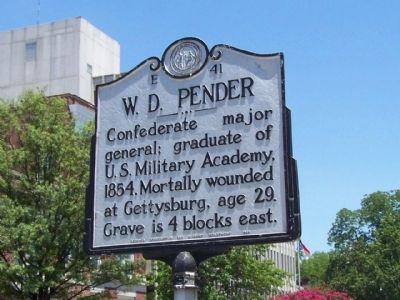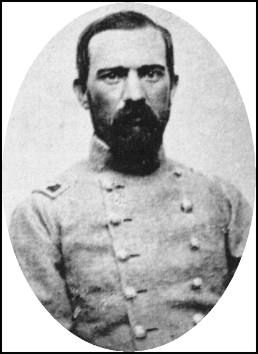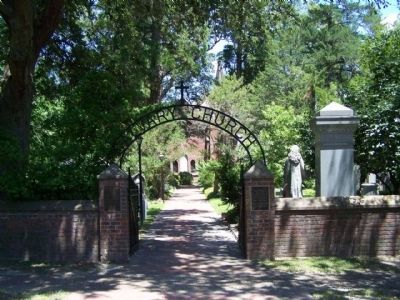Tarboro in Edgecombe County, North Carolina — The American South (South Atlantic)
W.D. Pender
Erected 1949 by North Carolina Office of Archives & History. (Marker Number E-41.)
Topics and series. This historical marker is listed in this topic list: War, US Civil. In addition, it is included in the North Carolina Division of Archives and History series list. A significant historical year for this entry is 1854.
Location. 35° 53.847′ N, 77° 32.059′ W. Marker is in Tarboro, North Carolina, in Edgecombe County. Marker is on West St. James Street near Main Street (U.S. 64), on the right when traveling east. Touch for map. Marker is in this post office area: Tarboro NC 27886, United States of America. Touch for directions.
Other nearby markers. At least 8 other markers are within walking distance of this marker. W.L. Saunders (a few steps from this marker); John C. Dancy (a few steps from this marker); Henry T. Clark (a few steps from this marker); Courthouse Square (within shouting distance of this marker); Knights of Labor (within shouting distance of this marker); The 1999 Flood (about 500 feet away, measured in a direct line); Edgecombe County Veterans Memorial (about 600 feet away); George H. White (about 800 feet away). Touch for a list and map of all markers in Tarboro.
Regarding W.D. Pender. William Dorsey Pender, Confederate major general, was born in Edgecombe County (present Wilson County) on February 6, 1834, the son of James and Sarah Routh Pender. Dorsey Pender, as he was commonly called, graduated from the U.S. Military Academy at West Point in 1854 in the same class as future Confederate generals J.E.B. Stuart and Stephen D. Lee, as well as Union general Oliver O. Howard.
From 1856 to 1860, Dorsey saw active service on the frontier in New Mexico, California, Oregon, and Washington as a member of the 1st U.S. Artillery and the 1st U.S. Dragoons. In March 1859 he married Mary Frances Shepherd and had three sons: Samuel Turner, William D., and Stephen Lee. In 1860, he was appointed adjutant of the 1st U.S. Dragoons stationed in San Francisco. At the outbreak of the Civil War, Pender resigned his commission, choosing to fight for his native state. Appointed an artillery captain by the Confederate government, he was sent to Baltimore as a recruiting officer.
In May 1861, Pender returned to North Carolina and instructed new regiments forming at Raleigh and Garysburg. He was elected colonel of the 3rd North Carolina Volunteers (13th N.C. Troops), and then transferred as commander of the 6th North Carolina Troops. In combat at Seven Pines, during the Seven Days Battles, Pender performed so valiantly that he received a promotion to brigadier general. Pender commanded the brigade throughout the Peninsular Campaign and was wounded at Malvern Hill. Returning to duty, he was wounded again at Second Manassas, but continued on through the Maryland Campaign, Fredericksburg where he was wounded a third time, and Chancellorsville.
At Chancellorsville, Pender took command of A. P. Hill’s division when Hill was wounded. Following the death of Stonewall Jackson Hill was promoted to command of the Army of Northern Virginia’s Third Corps, and Pender received promotion to major general in command of Hill’s division. Lee wrote of the 29-year-old: “Pender is an excellent officer, attentive, industrious and brave; has been conspicuous in every battle, and, I believe, wounded in almost all of them.”
Two months after Chancellorsville, Pender led the division in Lee’s invasion of Pennsylvania. On July 2, 1863, Pender was struck by a piece of artillery shell while leading his division in an assault on Cemetery Hill at the Battle of Gettysburg. He was evacuated to Staunton, Virginia, where he underwent a botched amputation of his leg. The procedure ruptured an artery, and he bled to death on July 18, 1863. His body was returned to North Carolina, and he was buried in Calvary Churchyard in Tarboro. After his death, Lee remarked, “His promise and usefulness as an officer were only equaled by
the purity of excellence in his private life.”
Pender County is named for W. D. Pender. In World War II, the U.S. Navy commissioned a Liberty Ship, the SS William D. Pender, in his honor. (North Carolina Office of Archives & History)
Credits. This page was last revised on June 16, 2016. It was originally submitted on July 23, 2011, by Mike Stroud of Bluffton, South Carolina. This page has been viewed 769 times since then and 28 times this year. Photos: 1, 2, 3, 4. submitted on July 23, 2011, by Mike Stroud of Bluffton, South Carolina.



